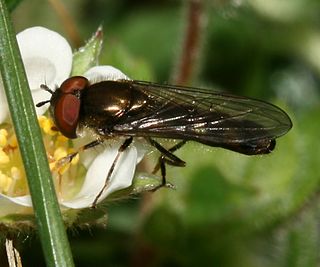
Hoverflies, also called flower flies or syrphids, make up the insect family Syrphidae. As their common name suggests, they are often seen hovering or nectaring at flowers; the adults of many species feed mainly on nectar and pollen, while the larvae (maggots) eat a wide range of foods. In some species, the larvae are saprotrophs, eating decaying plant and animal matter in the soil or in ponds and streams. In other species, the larvae are insectivores and prey on aphids, thrips, and other plant-sucking insects.

Eristalinus taeniops is a species of hoverfly, also known as the band-eyed drone fly.

Syrphus ribesii is a very common Holarctic species of hoverfly. Its larvae feed on aphids. In common with many other species of hoverfly, males have the eyes meeting on the top of the head, whilst females have their eyes widely separated.

Xylota segnis, The Brown-toed Forest Fly, is a common species of hoverfly.

Chrysotoxum bicinctum is a species of hoverfly.

Myathropa florea, sometimes referred to as the Batman hoverfly, is a very common European and North African species of hoverfly. Adults may be seen on flowers from May to September. It is of a similar size to the common drone fly, but Myathropa are generally more yellow, with two light bands to the thorax, interrupted with a black central smudge. In museum specimens, any yellow colour soon fades to brown after death. Like most species in the tribe Eristalini, Myathropa are rather variable in size, shape and colour.

Eupeodes luniger is a common species of hoverfly.

Leucozona lucorum is a Palearctic and Nearctic species of hoverfly.

Parasyrphus is a genus of hover fly found in the holarctic area of the world including species like Parasyrphus tarsatus located in some very northern areas. Very few of the 31 identified species have known larvae. Of the known larvae most are predators of tree aphids with one, Parasyrphus nigritarsis, that feed on beetle eggs and larvae.

Scaeva selenitica is a species of hoverfly.

Sphaerophoria scripta, the long hoverfly, is a species of hoverfly belonging to the family Syrphidae.

Baccha elongata is a species of hoverfly in the genus Baccha.

Platycheirus albimanus is a common widespread species of hoverfly. A holarctic species its range includes Greenland, Iceland, Britain, mainland Europe, Russia, across Siberia to the pacific coast, the Philippines, Alaska, western Canada and United States.
Chamaesyrphus is a genus hoverflies, from the family Syrphidae, in the order Diptera. Small yellow and black flies. Antennae with segment 3 large and almost evenly rounded, the arista only slightly thickened towards base and inserted before the actual anterior dorsal tip of the segment. In contrast to Pelecocera.

Pelecocera is a Holarctic genus of Hoverflies, from the family Syrphidae, in the order Diptera. Antennae with segment 3 a half moon shape or triangular, in the female the arista very thick, spike-like, inserted at the anterior extremity of segment 3. They are small black and yellow or orange flies found mainly on heaths.

Epistrophe grossulariae is a Holarctic species of hoverfly.

Cheilosia latifrons is a species of 'flower flies' or hoverflies belonging to the family Syrphidae subfamily Eristalinae.

Paragus haemorrhous,the Black-backed Grass Skimmer is a common widespread species of hoverfly found in many parts of Europe, Africa and the Nearctic. Hoverflies can remain nearly motionless in flight. The adults are also known as flower flies for they are commonly found on flowers from which they get both energy-giving nectar and protein-rich pollen. The larvae are predators on aphids.

Epistrophe nitidicollis is a European and North American species of hoverfly.


















